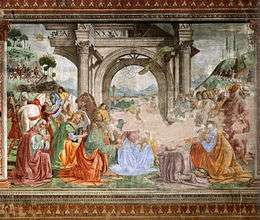Medici giraffe


The Medici giraffe was a giraffe presented to Lorenzo de' Medici in 1486 possibly by al-Ashraf Qaitbay, the Burji Sultan of Egypt, in an attempt to win the support of the Medici.
It caused a great stir on its arrival in Florence: although the Medici maintained a large menagerie, and had previously featured a giant mannequin of a giraffe in the animal entertainments they provided to the citizenry, this was the first time a living example had been seen in the city. It was also reputedly the first living giraffe to be seen in Italy since the days of Ancient Rome. It did not survive for long and another giraffe was not seen in Europe for almost 300 years.
History
In 46 BC Julius Caesar had celebrated his triumphs in Egypt by returning to Rome with a vast menagerie, the star attraction of which was a giraffe, the first ever seen in Europe. The Romans did not know what to make of such an animal and named it the cameleopard, for it seemed to them to embody characteristics of both the camel and leopard. Caesar had the animal torn to shreds by lions in the arena, probably to emphasize his power by the disposal of such a rare creature in a casual manner. Lorenzo had read of the success of the spectacle of Caesar's giraffe and saw a way to cement his reputation in Florence by emulating it. He also realised that he could gain further political influence by passing the animal on and promised to send it to Anne of France, after its sojourn in Florence.
Whether the giraffe was provided by Qaitbay is uncertain as there is no record of its procurement, but it seems likely: he is known to have had giraffes in his menagerie; he appealed for Lorenzo for help against the Ottomans around the time of the giraffe's arrival in Florence and Lorenzo did intercede on his behalf shortly afterwards.
The giraffe was an immediate sensation when it arrived in Florence. Although Cosimo de' Medici, Lorenzo's grandfather, had maintained a large menagerie, and had previously featured a giant mannequin of a giraffe in the animal entertainments he provided for the citizenry, this was the first time a living example had been seen in the city. Although there are reports that Frederick III of Sicily had been given a giraffe in 1261 by the Sultan of Egypt in exchange for a white bear and that the Duke of Calabria, Ercole I d'Este, Duke of Ferrara and Ferdinand I of Naples, all owned giraffes, if they had existed they had certainly not had the success that Lorenzo's giraffe enjoyed: it was immortalised in paintings by Botticini, Vasari and Bacchiacca, frescos and poetry. The poet Antonio Costanzo described it freely roaming the streets:
I have also seen it raise its head to those onlookers offering to it from their windows, because its head reaches as high as eleven feet, thus seeing it from afar the people think that they are looking at a tower rather than an animal. Ours appears to like the crowd, it is always peaceable and without fear, it even seems to watch with pleasure the people who come to look at it.
Although Anne had written reminding Lorenzo of his promise to send it to her, she was to be disappointed. Lorenzo had built special stables for it, either at the family's villa at Poggio a Caiano or in the Via della Scala in Florence itself, with heating to protect it from the damp Florentine winters. Shortly after its arrival the giraffe broke its neck and died after its head became stuck in the beams of these stables.
A living giraffe was not seen in Europe again until Mehmet Ali Pasha sent three giraffes as gifts in 1827, one to George IV of the United Kingdom, one to Francis II, Emperor of Austria, and one to Charles X of France. Each caused a stir, in London, Vienna and Paris respectively, but only the last, Zarafa, survived for more than two years.
References
| Wikimedia Commons has media related to Medici Giraffe. |
- Erik Ringmar. "Audience for a Giraffe: European Expansionism and the Quest for the Exotic" (PDF). Journal of World History, 17:4, December, 2006. pp. 353-97.
- Marina Belozerskaya (2006). The Medici Giraffe and Other Tales of Exotic Animals and Power. New York: Little,Brown, and Co. pp. 87–129. ISBN 0-316-52565-0.
